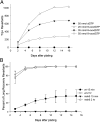Mismatch repair-dependent mutagenesis in nondividing cells
- PMID: 22474380
- PMCID: PMC3341054
- DOI: 10.1073/pnas.1115361109
Mismatch repair-dependent mutagenesis in nondividing cells
Abstract
Mismatch repair (MMR) is a major DNA repair pathway in cells from all branches of life that removes replication errors in a strand-specific manner, such that mismatched nucleotides are preferentially removed from the newly replicated strand of DNA. Here we demonstrate a role for MMR in helping create new phenotypes in nondividing cells. We show that mispairs in yeast that escape MMR during replication can later be subject to MMR activity in a replication strand-independent manner in nondividing cells, resulting in either fully wild-type or mutant DNA sequence. In one case, this activity is responsible for what appears to be adaptive mutation. This replication strand-independent MMR activity could contribute to the formation of tumors arising in nondividing cells and could also contribute to mutagenesis observed during somatic hypermutation of Ig genes.
Conflict of interest statement
The authors declare no conflict of interest.
Figures




Similar articles
-
Exonuclease 1 preferentially repairs mismatches generated by DNA polymerase α.DNA Repair (Amst). 2013 Feb 1;12(2):92-6. doi: 10.1016/j.dnarep.2012.11.001. Epub 2012 Dec 11. DNA Repair (Amst). 2013. PMID: 23245696 Free PMC article.
-
Reconstitution of long and short patch mismatch repair reactions using Saccharomyces cerevisiae proteins.Proc Natl Acad Sci U S A. 2013 Nov 12;110(46):18472-7. doi: 10.1073/pnas.1318971110. Epub 2013 Nov 1. Proc Natl Acad Sci U S A. 2013. PMID: 24187148 Free PMC article.
-
Mismatch repair, but not heteroduplex rejection, is temporally coupled to DNA replication.Science. 2011 Dec 23;334(6063):1713-6. doi: 10.1126/science.1210770. Science. 2011. PMID: 22194578 Free PMC article.
-
Non-canonical actions of mismatch repair.DNA Repair (Amst). 2016 Feb;38:102-109. doi: 10.1016/j.dnarep.2015.11.020. Epub 2015 Dec 2. DNA Repair (Amst). 2016. PMID: 26698648 Free PMC article. Review.
-
Eukaryotic Mismatch Repair in Relation to DNA Replication.Annu Rev Genet. 2015;49:291-313. doi: 10.1146/annurev-genet-112414-054722. Annu Rev Genet. 2015. PMID: 26436461 Free PMC article. Review.
Cited by
-
H3K36me3-mediated mismatch repair preferentially protects actively transcribed genes from mutation.J Biol Chem. 2018 May 18;293(20):7811-7823. doi: 10.1074/jbc.RA118.002839. Epub 2018 Apr 2. J Biol Chem. 2018. PMID: 29610279 Free PMC article.
-
Errors in mutagenesis and the benefit of cell-to-cell signalling in the evolution of stress-induced mutagenesis.R Soc Open Sci. 2017 Nov 1;4(11):170529. doi: 10.1098/rsos.170529. eCollection 2017 Nov. R Soc Open Sci. 2017. PMID: 29291054 Free PMC article.
-
Mismatch repair outside of replication.Cell Cycle. 2012 Aug 1;11(15):2773-4. doi: 10.4161/cc.21259. Epub 2012 Aug 1. Cell Cycle. 2012. PMID: 22801536 Free PMC article.
-
Different roles of eukaryotic MutS and MutL complexes in repair of small insertion and deletion loops in yeast.PLoS Genet. 2013 Oct;9(10):e1003920. doi: 10.1371/journal.pgen.1003920. Epub 2013 Oct 31. PLoS Genet. 2013. PMID: 24204320 Free PMC article.
-
A novel DNA damage response mediated by DNA mismatch repair in Caenorhabditis elegans: induction of programmed autophagic cell death in non-dividing cells.Genes Cancer. 2015 Jul;6(7-8):341-55. doi: 10.18632/genesandcancer.70. Genes Cancer. 2015. PMID: 26413217 Free PMC article.
References
-
- Li GM. Mechanisms and functions of DNA mismatch repair. Cell Res. 2008;18:85–98. - PubMed
-
- Iyer RR, Pluciennik A, Burdett V, Modrich PL. DNA mismatch repair: Functions and mechanisms. Chem Rev. 2006;106:302–323. - PubMed
-
- Jiricny J. The multifaceted mismatch-repair system. Nat Rev Mol Cell Biol. 2006;7:335–346. - PubMed
Publication types
MeSH terms
Substances
Grants and funding
LinkOut - more resources
Full Text Sources
Molecular Biology Databases

